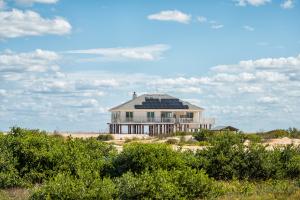
House Raising in Flood Zones: Process, Planning, and Long-Term Benefits
E.C.O. Builders Inc., based in Slidell, Louisiana, has worked extensively in regions affected by recurring flood events. According to Elwin Ordoyne, Vice President of E.C.O. Builders Inc., house raising is more than a construction project—it is a comprehensive process involving planning, engineering, and coordination with regulatory bodies.
“Elevation is a structural solution to a recurring environmental challenge,” said Ordoyne. “It allows structures to remain in place while adapting to new floodplain standards and minimizing future damage.”
The process begins with a site assessment. Structural conditions, soil stability, foundation type, and elevation targets are all evaluated to determine feasibility. Not all homes are candidates for elevation, but many—especially wood-framed or pier-and-beam structures—are adaptable to lifting procedures.
Once determined feasible, elevation plans are created in compliance with local floodplain management regulations and FEMA guidelines. These documents are reviewed and approved by city or parish officials. In many cases, grants or mitigation funding may be available to offset the cost, especially for homes that have suffered repetitive flood losses.
The physical raising process typically involves lifting the structure using synchronized hydraulic jacks while the home remains intact. This precision lifting allows the entire structure to be elevated in place without dismantling. Depending on the foundation type, a new elevated foundation—such as masonry piers, pilings, or a stem wall—is constructed beneath the lifted home.
Utilities such as plumbing, electrical, and HVAC systems are re-routed and reconnected to meet the new elevation height. This stage is coordinated with licensed professionals to ensure compliance with updated building codes and safety standards. Access features such as new staircases, decks, and wheelchair ramps are also constructed to restore full accessibility.
Timeframes vary depending on the size of the home, the complexity of the existing foundation, and weather conditions. While some projects can be completed in a matter of weeks, larger or more complex structures may require additional coordination and permitting time. Temporary relocation may be necessary while the lift and foundation work are in progress.
According to Ordoyne, the long-term benefits of house raising far outweigh the short-term inconvenience. “Elevated structures have a significantly reduced risk of flood damage, which can lower future insurance premiums and extend the usable life of the property.”
In addition to reduced insurance costs and fewer repair expenses, elevation can also contribute to peace of mind. In areas that flood frequently, elevated homes provide resilience—allowing families to remain in place rather than being forced to rebuild or relocate after each storm event.
House raising also plays a critical role in community resilience. By elevating multiple homes in a neighborhood, municipalities can reduce overall disaster recovery costs and improve the long-term sustainability of floodplain development. This aligns with federal and state-level hazard mitigation goals designed to reduce public spending on repetitive loss properties.
For residents in designated Special Flood Hazard Areas (SFHAs), elevation is often the most direct method of meeting Base Flood Elevation (BFE) requirements. Structures that remain below BFE are typically subject to higher insurance rates under the National Flood Insurance Program (NFIP) and are more vulnerable to future flood damage.
The benefits of house raising extend beyond financial protection. It also reduces environmental cleanup after flood events, limits exposure to mold and contaminants, and increases structural ventilation—particularly in older homes.
As climate patterns continue to shift and flood events increase in severity, communities across Louisiana are being encouraged to evaluate elevation as a long-term mitigation measure. In low-lying areas such as Slidell, Mandeville, New Orleans East, and parts of Plaquemines Parish, raising homes is becoming a common solution to an increasingly familiar problem.
E.C.O. Builders Inc. has assisted homeowners and municipalities with the technical, regulatory, and structural aspects of elevation projects throughout Southeast Louisiana. With extensive experience in both residential and commercial elevation, the firm continues to work closely with engineers, inspectors, and local agencies to ensure that each project meets safety, regulatory, and environmental standards.
House raising requires coordination, planning, and an understanding of both the physical structure and the surrounding floodplain conditions. When executed properly, it provides a lasting layer of protection against one of South Louisiana’s most persistent environmental threats.
As the region continues to recover and prepare for future storms, elevation remains a proactive strategy for protecting communities, properties, and the families who live in them.
Morgan Thomas
Rhino Digital, LLC
+1 504-875-5036
email us here
Visit us on social media:
Facebook
Distribution channels: Building & Construction Industry, Culture, Society & Lifestyle, Environment, Natural Disasters, Real Estate & Property Management
Legal Disclaimer:
EIN Presswire provides this news content "as is" without warranty of any kind. We do not accept any responsibility or liability for the accuracy, content, images, videos, licenses, completeness, legality, or reliability of the information contained in this article. If you have any complaints or copyright issues related to this article, kindly contact the author above.
Submit your press release

